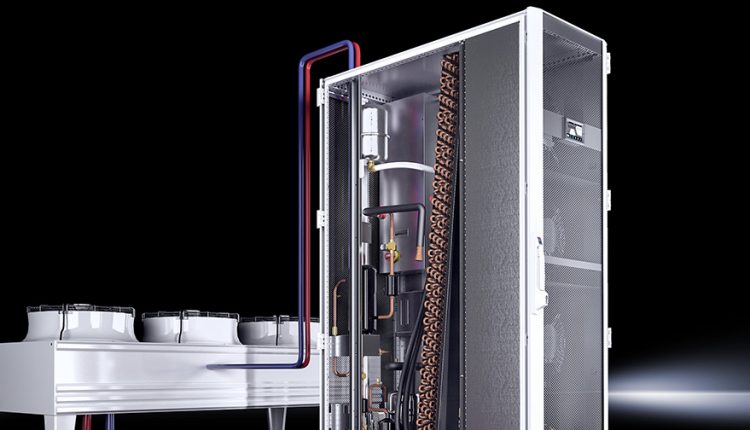Cooling for all edge scenarios
Twenty and 35kW output classes have been added by Rittal to its portfolio of refrigerant-based IT cooling solutions, meaning it can now offer a cooling solution from three to 55kW. The portfolio also includes a world first: a 35kW hybrid version that will utilize indirect free cooling where conditions are suitable, making it highly energy-efficient.
Compact cooling systems are also available in high-redundancy configurations. These meet the need of today’s IT infrastructure for high uptime, which is of particular importance for edge computing solutions to ensure the uninterrupted flow of data.
The innovative liquid cooling package (LCP) DX/FC Hybrid includes both a refrigerant circuit (DX = direct expansion) and a separate water circuit (CW = cold water). This means that the solution can deliver the required cooling output very efficiently, in line with external temperatures.
It’s a cost effective solution for locations with low to moderate ambient temperatures as it automatically switches to indirect free cooling when outside temperatures are low, using its external hybrid condenser with integrated free cooler. This use of indirect free cooling is key to helping lower operating costs.
The new LCP DX solutions for suite cooling have outputs of 20 and 35kW and suit small to mid-sized environments. Both devices are inverter-controlled and ideal for cooling IT hardware. They can precisely control the server inlet air temperature with a maximum deviation of approximately two kelvin. The cooling output is continuously adjusted in line with heat loss in the rack, minimizing energy consumption for cooling, and cutting IT operating costs.
Space-saving rack cooling with the typical ‘back-to-front’ air routing used in IT can be delivered through the roof-mounted cooling unit, even for smaller output categories (up to three kilowatts).
The LCU DX IT cooling unit is compactly designed and offers cooling outputs of three and 6.5kW, with or without redundancy. In order to save space, the internal unit is installed between the 19-inch rack and the side panel.
This solution, designed for maximum uptime, has two external units but only one internal unit. Inside is a heat exchanger with two cooling circuits, two power supply units and two separate controllers. It automatic switches over to its backup mode in the event of faults or when operating-hour thresholds are reached, increasing reliability in IT facilities that need to operate around the clock.
It reports any faults to the Rittal CMC III monitoring solution, and can also maximize energy efficiency by cooling individual racks, rather than the entire environment.
Rittal’s product suite includes water-based LCP CW rack and bayed suite cooling systems. Here too, the company is adding new products in the shape of IT cooling units with high cooling outputs, up to 55Kw, and a small footprint of only 0.36m², enabling the best possible use of available space.
Their high water inlet temperatures allow greater use of indirect free cooling, again, reduce operating costs. They can be deployed in conjunction with a heat pump, as their LCP CW glycol coolants can generate high water return temperatures.
The special features of these units include improved condensate management through an innovative spray eliminator employed in some LCP Inline CW models.
As a result, they are ideal for areas with high air humidity or low water inlet temperatures. Furthermore, a new plug-and-play mount means that the fan unit can be replaced without the need for tools.

